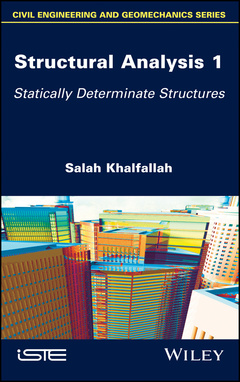Description
Structural Analysis 1
Statically Determinate Structures
Author: Khalfallah Salah
Language: English
Subject for Structural Analysis 1:
406 p. · 16.3x23.6 cm · Hardback
Description
/li>Contents
/li>Biography
/li>
Using a general approach, this book supports the student to enable mastery of the methods of analysis of isostatic and hyperstatic structures. To show the performance of the methods of analysis of the hyperstatic structures, selected beams, gantries and reticular structures are selected and subjected to a comparative study by the different methods of analysis of the hyperstatic structures.
Preface xi
Chapter 1. Introduction to Structural Analysis 1
1.1. Introduction 1
1.2. Concept of a structure 2
1.3. Structural analysis 2
1.4. History of structural analysis 3
1.5. Classification of structures 4
1.5.1. Plane trusses 4
1.5.2. Beams 6
1.5.3. Frames 7
1.5.4. Crossbeams 8
1.5.5. Arches 8
1.6. Static indeterminacy of structures 8
1.6.1. Trusses 9
1.6.2. Beam and frames 11
1.7. Sign convention 14
1.8. Conclusion 15
1.9. Problems 16
Chapter 2. Actions on Structures 21
2.1. Loads 21
2.2. Permanent loads 22
2.3. Live loads 23
2.4. Snow loads 26
2.5. Wind loads 29
2.6. Seismic loads 40
2.7. Thermal loads 47
2.8. Hydrostatic loads and land thrust 48
2.9. Conclusion 49
2.10. Problems 49
Chapter 3. External Analysis of Plane Structures 55
3.1. External equilibrium of structures 55
3.2. External and internal actions 57
3.2.1. External actions 58
3.2.2. Internal actions 58
3.3. Types of plane structure supports 59
3.4. Static determinacy, static indeterminacy and structural stability 59
3.4.1. External analysis 59
3.4.2. Internal analysis 61
3.5. Calculation of support reactions 63
3.6. Superposition principle 71
3.7. Matrix formulation 72
3.8. Concept of displacement 76
3.9. Concept of work 77
3.10. Principle of virtual work 80
3.11. Calculation of reactions by the virtual work method 81
3.12. Conclusion 84
3.13. Problems 85
Chapter 4. Analysis of Trusses 91
4.1. Definition of a truss 91
4.2. Hypothesis of analysis 92
4.3. Sign convention and representation of internal forces 93
4.4. Degree of static indeterminacy and stability of trusses 94
4.4.1. External analysis 94
4.4.2. Internal analysis 95
4.5. Analysis methods of trusses 96
4.5.1. Method of joint equilibrium 97
4.5.2. Method of sections 100
4.5.3. Matrix method 104
4.5.4. Graphic or Cremona method 109
4.6. Composite trusses 111
4.7. Complex trusses 118
4.8. Space trusses 120
4.8.1. Space truss analysis 121
4.9. Conclusion 127
4.10. Problems 127
Chapter 5. Internal Analysis of Beams and Frames 135
5.1. Normal force, shear force and bending moment 135
5.2. Sign convention 137
5.3. Beam analysis procedure 138
5.4. Diagrams of internal actions 143
5.5. Relationship between loading, shear force and bending moment 146
5.6. Static determinacy, static indeterminacy and instability of beams and frames 147
5.7. Plane frame analysis procedure 148
5.8. Conclusion 160
5.9. Problems 160
Chapter 6. Deflections of Elastic Beams: Energy Methods 167
6.1. Elastic deflection of beams 167
6.2. Calculation of deflections 169
6.2.1. Method of the differential equation of the elastic line 169
6.2.2. Direct integration method 173
6.2.3. Moment-area method. 176
6.2.4. Conjugate beam method 181
6.3. Superposition principle 185
6.4. Conclusion 188
6.5. Problems 189
Chapter 7. Structural Deflections: Energy Methods 193
7.1. Work of external actions 193
7.2. Internal or strain energy 200
7.3. Principle of energy conservation 204
7.4. Principle of virtual work 208
7.4.1. Method of virtual work: trusses 211
7.4.2. Method of virtual work: beams 217
7.4.3. Method of virtual work: frames 225
7.5. Conservation of energy and strain energy 231
7.6. Castigliano’s theorem 231
7.6.1. Displacement theorem statement 232
7.6.2. Slope theorem statement 232
7.6.3. Application of Castigliano’s theorem to truss analysis 234
7.6.4. Using Castigliano’s theorem to analyze beams and frames 236
7.7. Maxwell–Betti law 241
7.8. Conclusion 245
7.9. Problems 246
Chapter 8. Cable Analysis 253
8.1. Introduction 253
8.2. Mechanical characteristics of cables 254
8.3. Hypothesis of cable analysis 255
8.4. Cable analysis 255
8.4.1. Cables subject to concentrated force 255
8.4.2. Cables subject to distributed forces 263
8.4.3. Cables subject to any force 272
8.5. Cables with an inflection point outside the cable 275
8.6. Suspension bridges 280
8.7. Conclusion 283
8.8. Problems 284
Chapter 9. Analysis of Arches 289
9.1. Introduction 289
9.2. Three-hinged arch 290
9.2.1. Semicircular arch under concentrated load 291
9.2.2. Semicircular arch under uniformly distributed load 299
9.2.3. Parabolic arch under concentrated load 302
9.2.4. Parabolic arch under uniformly distributed load 309
9.2.5. Semicircular arch with support settlements 314
9.3. Bi-hinged arch 319
9.4. Conclusion 323
9.5. Problems 323
Chapter 10. Influence Lines 329
10.1. Introduction 329
10.2. Influence line definition 330
10.3. Influence lines of a beam using the equilibrium method 330
10.3.1. Influence lines of a support reaction 331
10.3.2. Influence line of a shear force 332
10.3.3. Influence line of a bending moment 333
10.4. Influence lines of a frame using the equilibrium method 338
10.4.1. Influence line of support reaction VA 339
10.5. Analysis steps 344
10.6. Influence lines of trusses 353
10.7. Influence lines using the Muller–Breslau principle 356
10.7.1. Influence lines of a support reaction 356
10.7.2. Influence line of a shear force 360
10.7.3. Influence line of a bending moment 366
10.9. Conclusion 375
10.10. Problems 376
Appendices 381
Bibliography 383
Index 387




